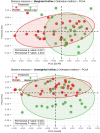Comparison of ruminal microbiota, IL-1β gene variation, and tick incidence between Holstein × Gyr and Holstein heifers in grazing system
- PMID: 38468851
- PMCID: PMC10925795
- DOI: 10.3389/fmicb.2024.1132151
Comparison of ruminal microbiota, IL-1β gene variation, and tick incidence between Holstein × Gyr and Holstein heifers in grazing system
Abstract
Introduction: The variation in bacterial communities among breeds has been previously reported and may be one of the reasons why Holstein × Gyr dairy heifers have better development in grazing systems in tropical conditions. This study aimed to explore the ruminal microbiota composition, the IL-1β gene variation, tick incidence, and blood parameters of Holstein × Gyr (½ Holstein × ½ Gyr) and Holstein heifers grazing intensely managed Guinea grass (Panicum maximum Jacq. cv. Mombaça).
Methods: Sixteen heifers were divided into two groups consisting of 8 Holstein × Gyr and 8 Holstein heifers. The experimental period was comprised of 3 periods of 21 days. Ruminal samples were taken via the stomach tube technique. The sequencing of the V4 hypervariable region of the 16S rRNA gene was performed using the Illumina MiSeq platform. Counting and collection of ticks were conducted each 21 days. Blood and skeletal muscle tissue biopsies were performed at the end of the experiment.
Results: Firmicutes were the most abundant phyla present in both breed rumen samples and Bacteroidota showed differences in relative abundance between breed groups, with greater values for Holstein heifers (p < 0.05 with FDR correction). The 10 most abundant unique OTUs identified in each breed included several OTUs of the genus Prevotella. Holstein heifers had a greater tick count and weight (9.8 ticks/animal and 1.6 g/animal, respectively) than Holstein × Gyr (2.56 ticks/animal and 0.4 g/animal, respectively). We found nucleotide substitutions in the IL-1β gene that might be related to adaptation and resistance phenotypes to tick infestation in Holstein × Gyr heifers. Blood concentrations of urea, albumin, insulin-like growth factor 1, triiodothyronine, and thyroxine were greater in Holstein × Gyr than in Holstein heifers.
Conclusion: Adaptations in Holstein × Gyr heifers such as ruminal microbiota, tick resistance, nucleotide substitutions in IL-1β gene, and hormone concentration suggest a better energy metabolism and thermoregulation resulting in better performance in tropical grazing systems.
Keywords: Guinea grass; crossbred heifer; heat stress; pasture; rumen microbiology.
Copyright © 2024 Quirino, Marcondes, Oliveira, Guimarães, Silva, Suen, Rossi, Cunha, Mantovani and Rotta.
Conflict of interest statement
The authors declare that the research was conducted in the absence of any commercial or financial relationships that could be construed as a potential conflict of interest.
Figures






Similar articles
-
Intake, performance, and feeding behavior of Holstein and Holstein × Gyr heifers grazing intensively managed tropical grasses during the rainy season.Animal. 2022 Sep;16(9):100613. doi: 10.1016/j.animal.2022.100613. Epub 2022 Aug 12. Animal. 2022. PMID: 35964480
-
Performance and feeding behavior of Holstein and Holstein × Gyr crossbred heifers grazing temperate forages.Trop Anim Health Prod. 2022 Feb 10;54(2):100. doi: 10.1007/s11250-022-03106-w. Trop Anim Health Prod. 2022. PMID: 35142920
-
Energy and protein requirements of Holstein × Gyr crossbred heifers.Animal. 2020 Sep;14(9):1857-1866. doi: 10.1017/S1751731120000622. Epub 2020 Apr 6. Animal. 2020. PMID: 32248874
-
Feed intake, milk production and metabolism of Holstein, Gyr and Girolando-F1 heifers with high body condition score during the transition period.Res Vet Sci. 2022 Dec 20;152:127-133. doi: 10.1016/j.rvsc.2022.07.025. Epub 2022 Aug 6. Res Vet Sci. 2022. PMID: 35961130
-
Supplementation strategies affect the feed intake and performance of grazing replacement heifers.PLoS One. 2019 Sep 16;14(9):e0221651. doi: 10.1371/journal.pone.0221651. eCollection 2019. PLoS One. 2019. PMID: 31525216 Free PMC article.
References
-
- Abreu M. B., Cunha C. S., Costa J. H. C., Miller-Cushon E. K., Rotta P. P., Machado A. F., et al. . (2022). Performance and feeding behavior of Holstein and Holstein × Gyr crossbred heifers grazing temperate forages. Tropl. Anim. Health Prod. 54:100. doi: 10.1007/s11250-022-03106-w, PMID: - DOI - PubMed
-
- Anderson M. J. (2001). A new method for non-parametric multivariate analysis of variance. Austral Ecol. 26, 32–46. doi: 10.1111/j.1442-9993.2001.01070.pp.x - DOI
-
- Brannan J. L., Riggs P. K., Olafson P. U., Ivanov I., Holman P. J. (2014). Expression of bovine genes associated with local and systemic immune response to infestation with the lone star tick, Amblyomma americanum. Ticks Tick Borne. Dis. 5, 676–688. doi: 10.1016/j.ttbdis.2014.04.022, PMID: - DOI - PubMed
LinkOut - more resources
Full Text Sources

